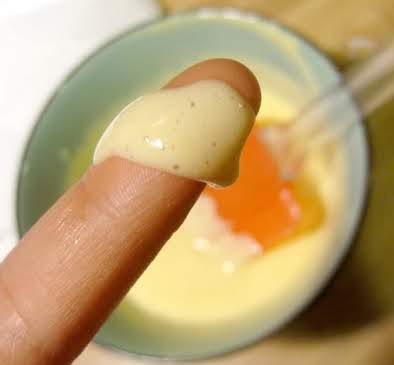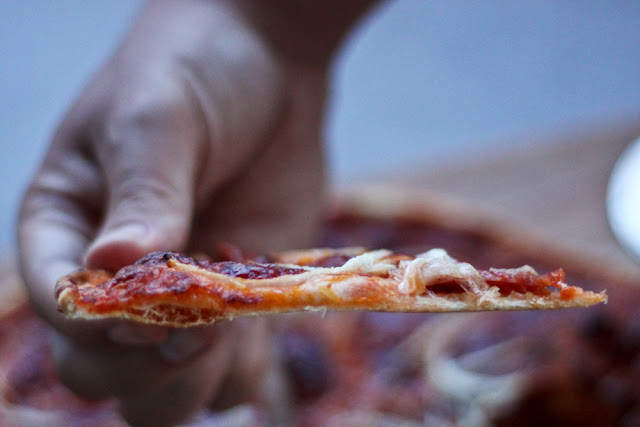creme anglaise
Tomorrow I finally get to post my Daring Baker's challenge. I made the recipe weeks ago and have been patiently waiting until the 27th for the monthly reveal. One.... more..... day.
Anyways, I can't post about what I made for the challenge. But I made some creme anglaise to complement the dish (it wasn't part of the dessert, just something I wanted to add on my own) so I figured I could at least share that with you.
Creme anglaise is a sauce similar in taste to a creme brulee but with more of a liquidy consistency. Custardy goodness that turns any dessert into a fat-ass decadent one. Just the way I like them.
I'd never made it before, but it's SUPER simple. Just a few key steps and you're on your way to making a fancy schmancy dessert accompaniment.
The basic ingredients are egg yolks, sugar and half and half.
First thing you want to do is heat your half and half just before it starts to boil. You'll notice it gets foamy a little before the bubbles start to break the surface.
While the cream is heating, combine the egg yolks and sugar in a bowl.
Once the cream is ready, temper the yolks by just adding a few tablespoons of the warm liquid. (If you add it all at once you'll have delicious and creamy scrambled eggs...)
After you've added a little bit, go ahead and slowly add the rest of the cream.
Return the mixture back into your pot and continue to heat on medium/ medium-low heat. Bring the mixture back to just below boiling (~170-175 degrees F).
If you don't have a thermometer, fear not. It's actually really easy to tell when its ready: the mixture (almost all of a sudden) will get quite thick. That's when you know its done.
Here's another trick: it's called the spoon test.
Now when you first bring your yolk/cream mixture back into the pot and start heating it it is quite liquidy. So the liquid doesn't stick to your spoon.
But then, after the magical point in time when the custard is done, its increased thickness causes it to form a nice little coat on your spoon.
And if you take your finger and run it across the spoon, the streak should remain intact. See?
If it wasn't done yet, there would be cream running down through the streak instead of being able to hold itself perfectly on the spoon.
And there you have it. Perfect creme anglaise.
Buen Provecho,
Jackie
Creme Anglaise, adapted from Joy of Baking (online)
Note: I cut the recipe in half when I made it. Just do your best cutting the last yolk in half. :)
Ingredients
2 cups (480 ml) light cream or half and half (12 - 18% butterfat)
1 vanilla bean, split lengthwise (can be found specialty food stores) or 2 teaspoons pure vanilla extract
1/3 cup (66 grams) granulated white sugar
5 large egg yolks
Directions
Have a fine medium-sized strainer and bowl ready near the stove.
1. In a bowl stir together the sugar and yolks until well blended. (Do not let this mixture sit too long or a film will develop on the yolks.)
2. In a medium sized saucepan heat the cream and vanilla bean (if using) just to the boiling point. Remove from heat and whisk a few tablespoons of the cream into the yolk mixture. Then, gradually add the remaining cream, whisking constantly.
3. Pour this mixture back into your saucepan and, over medium heat, gently heat the mixture to just below the boiling point (170 - 175 degrees F). You will notice that steam will begin to appear and the mixture will be slightly thicker than heavy cream. Do not boil or the eggs will curdle. (If you do not have a thermometer, use this test to see if it is the right consistency. Hold a wooden spoon sideways that is covered with the custard and run your finger along the back of the spoon. If the streak remains without the cream running down through the streak, it is ready.)
4. Immediately remove from the heat and pour through the strainer, scraping up any thickened cream that settles on the bottom of the pan. Remove the vanilla bean and scrape the seeds into the sauce. Stir until seeds separate. For maximum flavor, return the pod to the sauce until serving time. (If you are using pure vanilla extract, instead of the vanilla bean, add it to the cream now.)
The creme anglaise can be refrigerated covered with plastic wrap for a couple of days.
Note: If sauce was overheated and curdling occurs, pour instantly into a blender and process until smooth before straining. If necessary, add a little heavy cream to the mixture before blending.
Makes about 2 cups (480 ml).
Anyways, I can't post about what I made for the challenge. But I made some creme anglaise to complement the dish (it wasn't part of the dessert, just something I wanted to add on my own) so I figured I could at least share that with you.
Creme anglaise is a sauce similar in taste to a creme brulee but with more of a liquidy consistency. Custardy goodness that turns any dessert into a fat-ass decadent one. Just the way I like them.
I'd never made it before, but it's SUPER simple. Just a few key steps and you're on your way to making a fancy schmancy dessert accompaniment.
The basic ingredients are egg yolks, sugar and half and half.
First thing you want to do is heat your half and half just before it starts to boil. You'll notice it gets foamy a little before the bubbles start to break the surface.
After you've added a little bit, go ahead and slowly add the rest of the cream.
If you don't have a thermometer, fear not. It's actually really easy to tell when its ready: the mixture (almost all of a sudden) will get quite thick. That's when you know its done.
Here's another trick: it's called the spoon test.
Now when you first bring your yolk/cream mixture back into the pot and start heating it it is quite liquidy. So the liquid doesn't stick to your spoon.
But then, after the magical point in time when the custard is done, its increased thickness causes it to form a nice little coat on your spoon.
And if you take your finger and run it across the spoon, the streak should remain intact. See?
If it wasn't done yet, there would be cream running down through the streak instead of being able to hold itself perfectly on the spoon.
And there you have it. Perfect creme anglaise.
Buen Provecho,
Jackie
Creme Anglaise, adapted from Joy of Baking (online)
Note: I cut the recipe in half when I made it. Just do your best cutting the last yolk in half. :)
Ingredients
2 cups (480 ml) light cream or half and half (12 - 18% butterfat)
1 vanilla bean, split lengthwise (can be found specialty food stores) or 2 teaspoons pure vanilla extract
1/3 cup (66 grams) granulated white sugar
5 large egg yolks
Directions
Have a fine medium-sized strainer and bowl ready near the stove.
1. In a bowl stir together the sugar and yolks until well blended. (Do not let this mixture sit too long or a film will develop on the yolks.)
2. In a medium sized saucepan heat the cream and vanilla bean (if using) just to the boiling point. Remove from heat and whisk a few tablespoons of the cream into the yolk mixture. Then, gradually add the remaining cream, whisking constantly.
3. Pour this mixture back into your saucepan and, over medium heat, gently heat the mixture to just below the boiling point (170 - 175 degrees F). You will notice that steam will begin to appear and the mixture will be slightly thicker than heavy cream. Do not boil or the eggs will curdle. (If you do not have a thermometer, use this test to see if it is the right consistency. Hold a wooden spoon sideways that is covered with the custard and run your finger along the back of the spoon. If the streak remains without the cream running down through the streak, it is ready.)
4. Immediately remove from the heat and pour through the strainer, scraping up any thickened cream that settles on the bottom of the pan. Remove the vanilla bean and scrape the seeds into the sauce. Stir until seeds separate. For maximum flavor, return the pod to the sauce until serving time. (If you are using pure vanilla extract, instead of the vanilla bean, add it to the cream now.)
The creme anglaise can be refrigerated covered with plastic wrap for a couple of days.
Note: If sauce was overheated and curdling occurs, pour instantly into a blender and process until smooth before straining. If necessary, add a little heavy cream to the mixture before blending.
Makes about 2 cups (480 ml).









Comments
Post a Comment